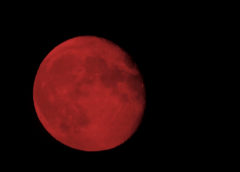The first full moon and the first lunar eclipse of 2019 will occur on Sunday night-Monday morning, January 20-21, 2019.
The eclipse will also occur on the night of a supermoon, which will make it more spectacular. Themoon will be nearly at its closest to Earth for this January, as the eclipse takes place.
Supermoom: A supermoon is a full moon or a new moon that nearly coincides with perigee—the closest that the Moon comes to the Earth in its elliptic orbit—resulting in a slightly larger-than-usual apparent size of the lunar disk as viewed from Earth.[1] The technical name is a perigee syzygy (of the Earth–Moon–Sun system) or a full (or new) Moon around perigee.[a] The term supermoon is astrological in origin and has no precise astronomical definition.[2]
Who will see the eclipse? Thetotal eclipse can be viewed from North and South America, Greenland, Iceland, Europe, northern and western Africa and the Earth’s Arctic regions.
If you live in North America, start time will be at 10:34 p.m. EST.
So sit back, relax and enjoy the event, because it will be the 26thof May, 2021 when the next total lunar will occur.
Here are a few resources:
The total lunar eclipse of January 20-21: Earth-Sky https://earthsky.org/tonight/supermoon-lunar-eclipse-january-20-21
What Planets Are Visible Tonight? – 2019 Astronomer’s Guide to the Night Sky: Hobby Help https://hobbyhelp.com/astronomy/planets-visible-tonight/
How to watch a total eclipse of the moon: Earth Sky https://earthsky.org/astronomy-essentials/how-do-i-watch-the-total-lunar-eclipse

Rod is a blogger, writer, filmmaker, photographer, daydreamer who likes to cook. Rod produces and directs the web series, CUPIC: Diary of an Investigator. He is also the editor, producer and administrator of STM Daily News, a part of the TNC Network.

